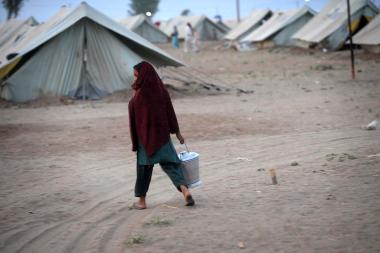Twelve ways to take anticipatory action to scale in conflicts and recurring crises
This policy brief reflects SPARC’s learning on why the main models used by the international humanitarian community for planning anticipatory action show limited promise in difficult places and what alternative approaches might be more helpful.
Humanitarian agencies are giving progressively more attention to anticipatory action, i.e. proactive response to the threat of a crisis. But successful models for such action are not necessarily replicable in ‘difficult places’ with conflicts and recurring crises. Conflicts affect everything that can happen where it occurs.
SPARC has conducted many research studies over the past five years about enhancing livelihoods in these difficult places, including studies that directly looked at early warning and anticipatory action. The policy review looked at all SPARC publications, and it distils all of the findings and recommendations that are relevant to supporting anticipatory action in conflicts and recurring crises.
This brief does not set out a full analysis of everything that is known about anticipatory action in conflicts and recurring crises. It limits itself to synthesising the lessons from SPARC’s other studies. Each had its own methodological approach.
Findings
Successful anticipatory action has mainly been achieved in an overall context of a functioning state, within an economy that remains largely unaffected by a disaster that is limited in scope and duration, and where there are markets that work.
These conditions exclude conflicts and recurring crises where it is harder to:
- identify when to trigger ‘anticipatory’ action, because there may be no pre-crisis normality
- find interventions that can allow people to head off crisis, where people are already using every coping strategy possible and where the spike in crisis may last more than a few months
- implement effective action, given that the functioning of state institutions is usually highly constrained and trust in society is usually low.
Policy implications
- In places with conflicts and/or recurrent crises, it is not possible to replicate anticipatory projects that have been successful elsewhere. Anticipatory action is much harder where there is no pre-crisis normality, no predictable trajectory for any crisis and it is harder to define obvious triggers in advance.
- Conflicts affect everything. They shape how shocks affects people, and also what actions are feasible, and who will benefit from any action. In places with conflict, it is essential to ask three questions:
- How will the conflict affect the impacts of the forecast shock?
- How will the conflict affect plans to respond to the forecasts?
- How will the plans affect conflict?
- Anticipatory action cannot be planned in isolation. It must be part of an overall strategy of disaster risk management (DRM).
- Centralised models of anticipatory action and tying funds to a single set of triggers at national level are incompatible with the flexibility needed to be context-appropriate, and responsive to local situations and their windows of opportunity for action.
- Promoting anticipatory action means supporting everyone’s capacity to make their own forward-looking decisions. Governments and other agencies should not focus solely on implementing their own pre-planned, pre-funded projects.



